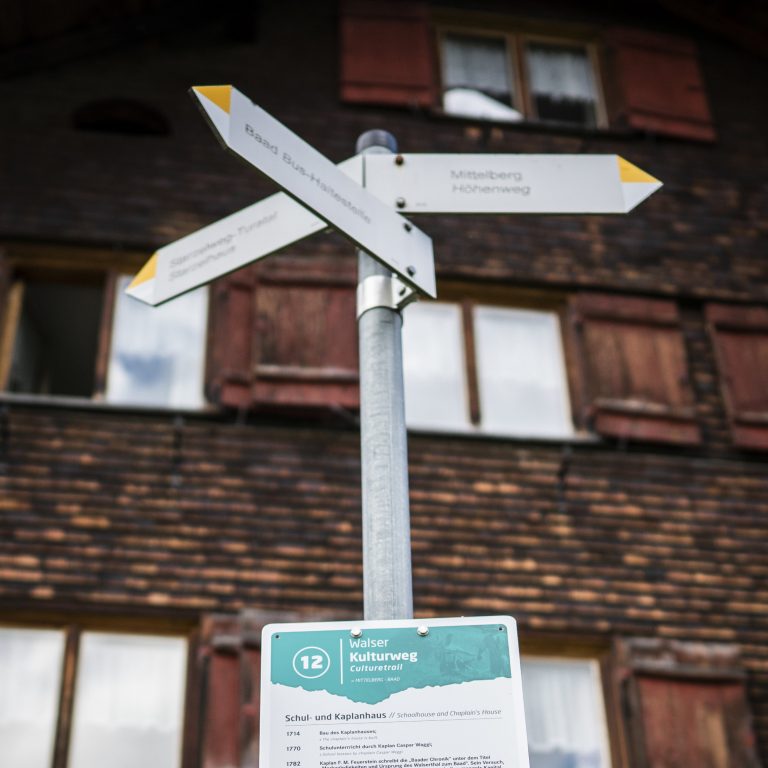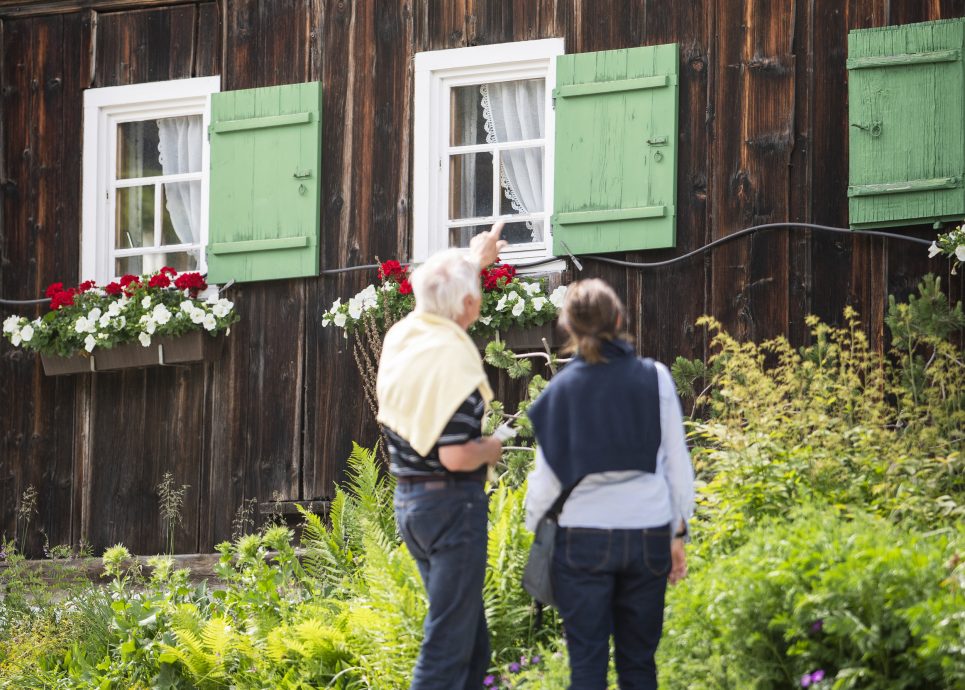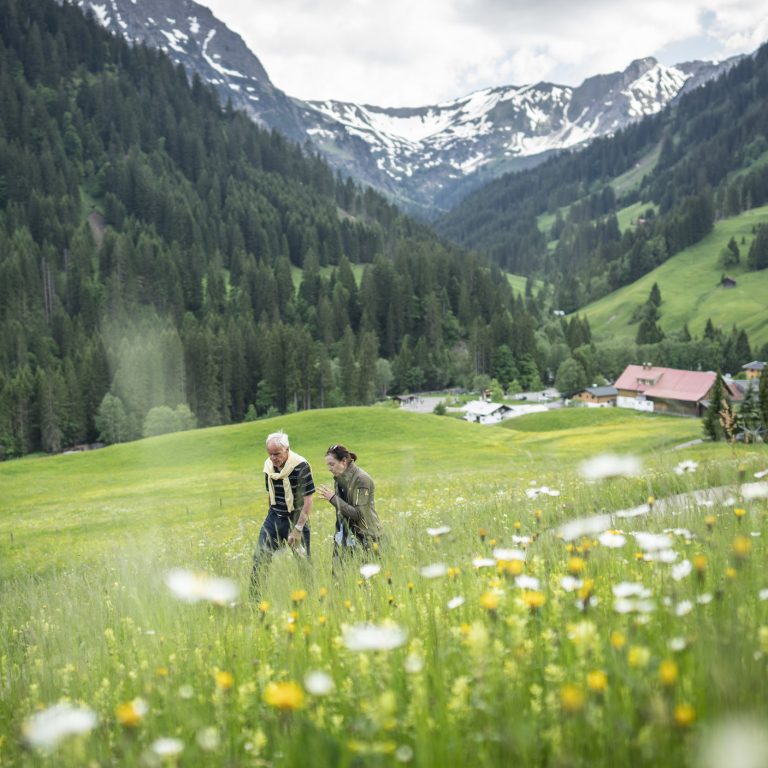


Remembering: panels explain sights worth seeing – including the Walserhaus (Walser House)
Meeting: Wolfgang Hilbrand with author Kornelia Dietrich

C Walser Kulturweg © Dietmar Denger
The Walser Kulturweg – the Walser Culture Trail – runs through the entire Kleinwalsertal valley
It’s possible while hiking to discover stories that have been told for around 700 years and walk in the footsteps of Walser families in and around Mittelberg. A trip through time – with refreshingly modern stopovers.
TEXT: KORNELIA DIETRICH
We meet Wolfgang Hilbrand sitting on a bench at Mittelberg’s church. It can’t be missed as the starting point for our hike: its 66-metre-high spire is the village’s and – for many – even the entire Kleinwalsertal valley’s landmark. “It’s more than 600 years old and has never had to be even the entire Kleinwalsertal valley’s landmark. “It’s more than 600 years old and has never had to be restored,” says Wolfgang Hilbrand proudly. Five Walser families arrived here from Switzerland and settled here at the end of the 13th century. “They didn’t have any steel or iron so they built walls that are between two and a half and three metres thick in order to ensure that St. Joduk would last forever.”
The Walser have left their mark in many places between Riezlern and Baad. And so, a few years ago, Wolfgang Hilbrand came up with the idea of creating the Culture Trail, a hiking trail that takes visitors through beautiful scenery through the valley and at the same time explains many of the things that some people would otherwise pass by without noticing. The ‘Uusrüafschtei’, for example, which is a flat stone slab behind the church. “It weighs several tonnes and was dragged here on a sleigh in 1595 – there wasn’t any other way of transporting objects that were that heavy.” The Waibel, the usher, would stand on it every week after Sunday service and read the news: which meadows were to be sold or when the next cattle auction would be taking place. “That was the easiest way to reach the whole community since at the time everyone went to mass.” The church these days is often quite empty when Reverend Edwin Matt, whom Mittelberg shares with the neighbouring parishes, climbs the pulpit every second Sunday.
But, on this sunny afternoon, we meet many visitors who have come to see the frescoes, the beautiful altar and the painted wooden Vortragetafel (Carrier Panel) that the girls used to carry in front of them in processions, hence the name. “Are you from here?” A man asks whose accent clearly reveals that he’s from the Ruhr district. He then immediately follows that up with: “When does the Corpus Christi procession start tomorrow?”
We walk past the sacristan’s house, old Walser stables, the ‘Hoflaada’ (‘Farm Shop’), where the wooden Heinzen, which used to be used to hang small bundles of grass to dry in bad weather, are still to be seen above the doors. This is the place where tradition and modern technology meet – inside this building customers are able to draw fresh organic farm milk from the milk-vending machine – automatically, cooled and hygienically. Mountain cheese and yoghurt are also available from vending machines and we quickly get chatting with visitors from Bavaria who’ve come to us to change banknotes into coins so that they can pack the delicacies into their hiking rucksacks.
We knock on the door of the more than 450-year-old Kohler Walserhaus in Bödmen and are allowed in to admire the parlour with its wood panelling and ‘Herrgottswinkel’ (shrine) that has hardly changed for generations. We meet lots of hikers coming the other way who give us a friendly greeting as they pass. And local residents keep stopping Wolfgang to have a chat with him – everyone in Mittelberg seems to know him – no wonder, he was headmaster at the elementary school until he retired. And that’s why he also knows the gruesome stories that are associated with the 15th century conciliation crosses that we pass on our way. These are memorial crosses that murderers were forced to carve out of stone with their own hands and that were then installed at the scenes of their crimes: a man who got into an argument with his three brothers after a drinking session and killed them all or a father who killed his son.
We’re the most beautiful cul-de-sac in Austria.
Interested visitors, however, may also walk the Culture Trail without a guide because there’s a small guide to the sights, too, that’s available from the tourist office. And plaques have been installed at each monument that tell the associated stories; the texts were written by Wolfgang Hilbrand – so expertise and love of the homeland are guaranteed. We walk past the alpine woods, through colourful meadows full of dandelions, clover, crowfoots and buttercups. Bees buzz and swallows circle high above us until the trail gently descends to the chapel of St. Martin in Baad. Our guide thinks it’s a little gem – and not only because of the beautifully painted ceiling. “I’m particularly fond of this church because we celebrated our golden wedding anniversary here,” he says.
Baad is the last stop. Not only for our little trip – this is also where the Kleinwalsertal valley ends, the small village is surrounded by mountains, the only road leads back to Mittelberg. “We’re the most beautiful cul-de-sac in Austria,” says Wolfgang. “And we want it to stay that way – we’ve always resisted a through road.” Which they have fortunately done with success.
The Culture Trail runs through the entire Kleinwalsertal valley. An interactive digital map also provides information about the routes.
The Mittelberger Runde (Mittelberg Round Trip) is eight kilometres long. Hikers wishing to take their time at the 20 stations without hurrying should plan a good three hours for the tour.
There are similar round trips in Hirschegg (11 stations, 2.5 kilometres), Riezlern (10 stations, 13 kilometres) and a round trip around the valley (9 stations, 20 kilometres). And it’s always possible to hop on the Walserbus, which connects all the villages, to shorten the trip. The bus is free of charge for holders of the Kleinwalsertal Guest Card.